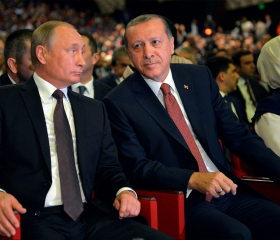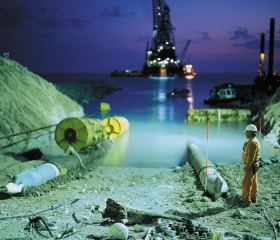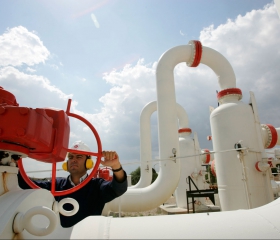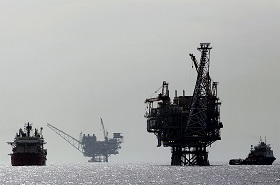On October 10th 2016, during 23rd World Energy Congress in Istanbul, Turkey and Russia finally signed an intergovernmental agreement to implement the Turkish Stream natural gas pipeline project. The agreement foresees the construction of two parallel pipelines with 15.75 billion cubic meters of annual (bcm/a) capacity. Among other important issue areas between Ankara and Moscow such as Syria and the Caucasus, the Turkish Stream project plays a pivotal role since it now demonstrates not only an eagerness but also a readiness between the two parties to cooperate especially after two years of talks.
On October 10th 2016, during 23rd World Energy Congress in Istanbul, Turkey and Russia finally signed an intergovernmental agreement to implement the Turkish Stream natural gas pipeline project. The agreement foresees the construction of two parallel pipelines with 15.75 billion cubic meters of annual (bcm/a) capacity. Among other important issue areas between Ankara and Moscow such as Syria and the Caucasus, the Turkish Stream project plays a pivotal role since it now demonstrates not only an eagerness but also a readiness between the two parties to cooperate especially after two years of talks.
In December 2014, Russian President V. Putin’s visit to Ankara was marked by the announcement of the cessation of South Stream and the proposal of the Turkish Stream gas pipeline project instead. Gazprom CEO Alexey Miller announced the signing of a MoU between Gazprom and Botaş for the construction of a 63 bcm/a new gas pipeline to Turkey under the Black Sea and the transportation of Russian gas to the Turkish-Greek border. However, the capacity of the project was reduced to more realistic amount of 31.5 bcm/a. The project is now envisaged to deliver gas for both the Turkish and Southeast European markets from the Russkaya compressor station on the Black Sea coast of Russia. The subsea part of the project will be constructed and owned by Gazprom. One of the lines will be built for the Turkish domestic market and Turkish state company Botaş will make the necessary investments, including in feeding lines and a receiving terminal in Kıyıköy in order to import Russian gas from the first line under the Black Sea. It’s expected that the 14 bcm/a contracted Russian gas that is currently imported by Turkish firms through the Ukraine-Moldova-Romania-Bulgaria route will be diverted to this new infrastructure by 2020 and almost the same amount is planned for the other Southeast European countries with the exception of Italy via the second line.
For the second line, a 50-50 % joint venture transmission company is planned to be formed between Gazprom and Botaş to own and operate the pipeline on Turkish territory. This company will not be involved in trade and marketing. Rather Gazprom will have exclusive rights to use 100% of the capacity and will market its own gas further onto Europe. But without the necessary agreements with the EU, Gazprom will find it difficult to export its gas beyond Turkey’s borders.
In fact, the importance of pipelines in international gas trade is diminishing but they are still at the core of energy transit security. Here it’s important to underline the fact that although the substance of energy security for energy-importing countries such as Turkey and those in the EU is the diversification of supply, the same concept is understood as diversification of demand for energy exporting countries in general and the diversification of transit routes into Europe for Russia in particular. Therefore, one should keep in mind that the Turkish Stream is one of the diversification projects of Moscow together with South Stream and Nord Stream 2 that would act to minimize any sort of transit risks.
Through the Turkish Stream pipeline project, Gazprom aims to reach the EU border from its southern flank as negotiations on South Stream did not proceed with Bulgaria. At the final point of the project is the Turkish-Greek border, where the Russian gas could be connected either to TAP (an exemption from EU 3rd energy package is granted for an initial 10 bcm capacity but remaining the 10 bcm capacity is open to third parties) or the Turkey-Greece gas pipeline, which has 6 bcm capacity and is currently underutilized. Later, after the completion of Greece-Bulgaria Interconnector, a link to Bulgaria could also be made. The targeting of the Turkish-Greek border is also rational since EU markets begin there and Gazprom can develop a new strategy in its gas business to export gas to EU borders without involving the delivery of gas to final users. The Turkish-Greek border is also an intersection point for different international projects including Turkish Stream, TANAP and other new ones that could theoretically provide gas supply from Iraqi, Iranian or Mediterranean sources in the future.
Nevertheless, the main motive for Gazprom in implementing these projects including Turkish Stream is to reduce the transit risks stemming from the Ukrainian route. Out of approximately 159 bcm/a Russian gas exports to Europe including Turkey, 67 bcm/a is pumped through the Ukrainian Gas Transmission System (GTS). Russia’s aim of fully avoiding Ukrainian GTS by 2020 could be possible if Nord Stream 2 and only 1st part of Turkish Stream are constructed though this seems hard to achieve.
EU-Russia-Turkey Energy Triangle
There are serious setbacks in EU-Russia energy relations, such as the investigations by the European Commission (EC) against Gazprom and the implementation of EU legislation on new infrastructure projects developed by Gazprom. The Russian side is in talks with the EC over the construction of Nord Stream 2 under the Baltic Sea but the latest decision by the Polish Competition Authority to block the European partners of Gazprom from participating in the project has made the situation more complicated. In that sense, there is energy containment coming from the EU against Russia and at this challenging moment Moscow needs to develop a counter move to break the containment. Here the signing of the Turkish Stream project with Ankara is a solution. Russia gains new leverage vis-à-vis the European Union by officially incorporating the Turkish Stream into the picture. In that sense, Russia will be able to use Turkish Stream as an instrument in its negotiations with EU for its larger aims. With this development, instead of established bilateral energy relations, now there is a more complex and dynamic energy triangle between the EU, Russia and Turkey.
Turkish Stream might turn out to be a good opportunity for Turkey since the project could act as a catalyst of change for better relations with Russia. From Turkey’s perspective, this project will not transform Turkey into a gas trading hub but it is beneficial for the country in the sense that it will be able to import all its gas needs from Russia directly, getting rid of transit risks that could stem from any new Russian-Ukrainian energy crisis. In addition, for Ankara, import diversification is an issue of top priority. When it comes to supply diversification, the first thing that comes to mind is to decrease the dependency on Russian gas, which is currently slightly more than half of total demand. Of the 160 bcm/a of Russian gas exported to Europe, Turkey is the second biggest customer of Gazprom with volumes of 27 bcm/a after Germany. Significantly decreasing import dependence on Russia is not possible in the near term but Ankara could strive to remove itself from the position of “end user” for Russian gas and focus much more on becoming an “intermediate user” if Russia can export via Turkey. Moreover, the project gives strategic leverage also to Turkey vis a vis EU as it brings Turkey closer to Russia at a time Turkey’s relations with the West are severely problematic. So geopolitically this project favors Turkey as well as Russia.
On the other hand, the project is misleadingly interpreted with a market-oriented point of view. Turkish gas imports are regulated under long-term contracts with take-or-pay clauses. However, significant progress has not been observed in the Turkish market structure that would support the official discourse of Ankara which sees the country as an emerging gas hub in the region. In spite of this discourse which states that the international projects will accelerate the general aim of Turkey becoming a natural gas hub in its region, focusing on reality, Turkey has not even been able to create its own competitive and liquid gas trade model domestically. It has not invested in necessary physical infrastructure, including storage. Turkish Stream, as a single project, will also not transform Turkey into a gas trading hub under current market conditions.
What’s Next for Turkish Stream?
If the construction of the first line of Turkish Stream is not too difficult to achieve by 2020, there are more complexities regarding the second line designed to feed Southeast European gas markets as well as Italy. The likelihood of the second line coming together actually depends more on settlements between Russia and the EU in the current form. Russia has to find a way to reach an agreement with the EC in order to avoid current legal obstacles. Therefore, a multi-dimensional energy game between EU and Russia will continue and the fate of Turkish Stream will dependent on general bargaining between the parties. There are several different scenarios:
The first option for Gazprom before it focuses on second line of Turkish Stream is to win some concessions from the EU for the higher utilization rate of already constructed OPAL pipeline and/or the realization of Nord Stream 2 project. Nord Stream 2 (55 bcm/a) plus just the first line of Turkish Stream (15.75 bcm/a) is more than enough to replace the Ukrainian GTS. In this framework, if only the first line is constructed, then Turkish Stream will become another Blue Stream: It means only a bilateral pipeline between Turkey and Russia under the Black Sea just to feed the Turkish domestic market.
The second option for Gazprom is to focus on building both lines. If it will be able come to terms with the EC for the construction of the second line of Turkish Stream, then Turkey will become an energy corridor for Russia, not a gas hub, under the current agreement. In fact, Turkey has already opted to become an energy corridor for Azeri gas through the TANAP project and now with the realization of second line of Turkish Stream, it will also become an energy corridor for Russian gas. In both projects, there will be neither a price setting mechanism nor transit revenues for Turkey, the opposite of Ukrainian case in which Ukrainian state company Naftogaz, as the sole owner of the GTS, charges transit fees from Gazprom for each gas molecule pumped.
The third option, on the other hand, is that Gazprom and EC might not agree on the supplies to EU gas market at all and Gazprom might not get permission to construct Nord Stream 2. In this case, the formation of a new gas trading company in Turkey with a Russian partnership which would be responsible for the marketing and re-exporting of Russian gas could be an alternative. In this case, the European customers will have to acquire the gas at the EU-Turkey borders and the EU legislation cannot stop this, since it is not in conflict with EC rules. This would avoid the third party access rules of the EU. But Russia is unlikely to agree to this third option. Therefore, the first option seems more likely for now.
Less Pragmatism, More Strategic Cooperation
The main feature of Turkey-Russia relations is that both parties see each other as an instrument to use in their relations with the West. This might be still logical for their relationship against the US but Ankara and Moscow should stop using each other to gain more leverage against the EU whose relative gravity in international affairs is diminishing. Turkey-Russia relations have been characterized by pragmatic cooperation for the last two decades and it is now time to talk about a deeper strategic cooperation between the two. Natural gas, as the core component of relations between Ankara and Moscow, could play a pivotal role here.
The prospects for the gas market in Europe are not clear and the market structure is in transition. There are converging, not diverging, interests between Russia and Turkey to play a more active role in the changing gas trade structure in Europe as the former is a supplier and the latter operates transit. In this sense, a cooperative gas hub to be formed in Turkey, what we call a “Eurasian Gas Hub”, between Turkish and Russian companies could be a viable solution for the two. Maybe now it is very difficult to think about the viability of such a project, but the energy game itself is unpredictable. The last but not the least energy triangle between EU-Turkey and Russia is dynamic and open to new surprises. Most likely, 2017 will be the last decisive year for taking a decision to focus on a concrete project among the different pipeline alternatives between the EU and Russia and the Turkish Stream has good chance to be implemented by 2020.








